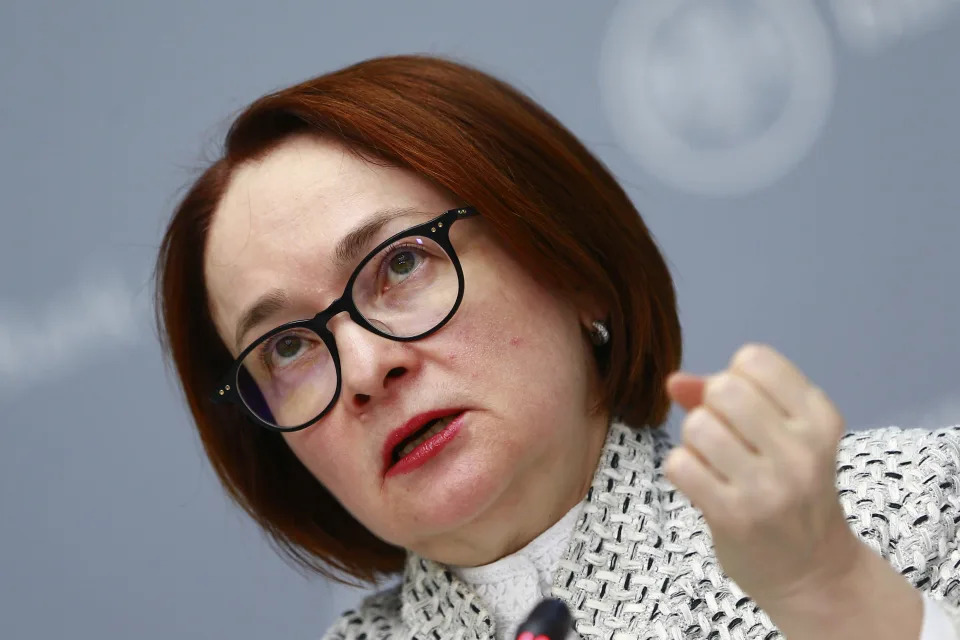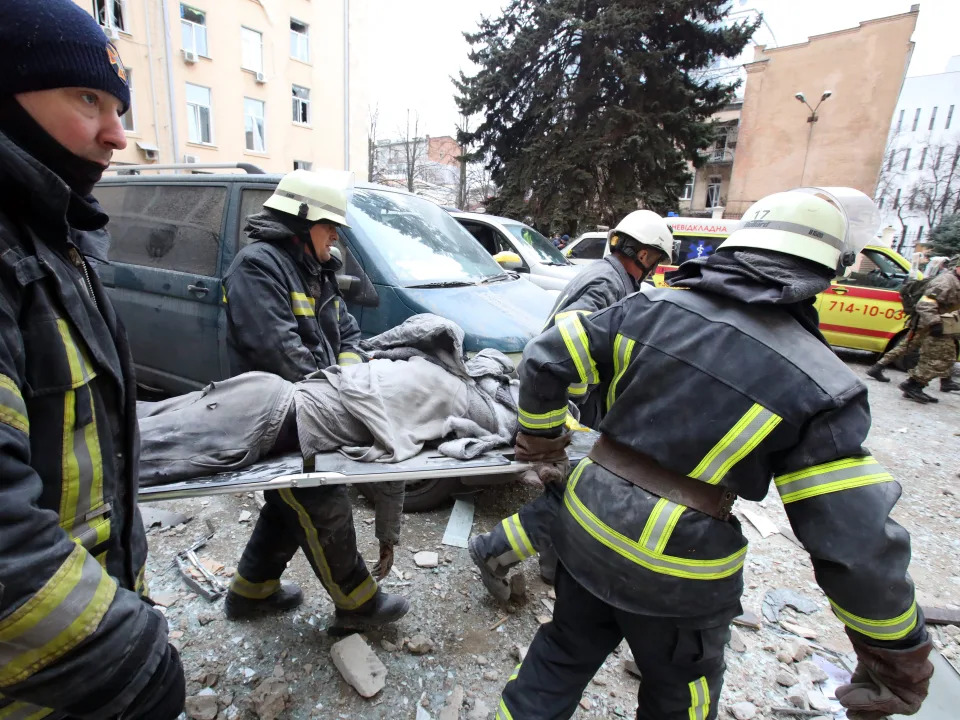Associated Press
Ukraine battered again; Zelenskyy says US officials to visit
David Keyton and Yesica Fisch and – April 22, 2022
KYIV, Ukraine (AP) — Russian forces in Ukraine tried to storm a steel plant housing soldiers and civilians in the southern city of Mariupol on Saturday in an attempt to crush the last pocket of resistance in a place of deep symbolic and strategic value to Moscow, Ukrainian officials said.
Ukrainian President Volodymyr Zelenskyy, meanwhile, announced he would meet Sunday in his nation’s capital with the U.S. secretary of state, Antony Blinken, and the U.S. secretary of defense, Lloyd Austin. The White House declined to comment.
Speaking at a news conference, Zelenskyy gave little detail about logistics of the encounter but said he expected concrete results — “not just presents or some kind of cakes, we are expecting specific things and specific weapons.”
It would be the first high-level U.S. trip to Kyiv since the war began Feb. 24. While visiting Poland in March, Blinken stepped briefly onto Ukrainian soil to meet with the country’s foreign minister. Zelenskyy’s last face-to-face meeting with a U.S. leader was Feb. 19 with Vice President Kamala Harris.
In attacks on the eve of Orthodox Easter, Russian forces pounded cities and towns in southern and eastern Ukraine.
A 3-month-old baby was among eight people killed when Russia fired cruise missiles at the Black Sea port city of Odesa, officials said. Zelenskyy said 18 more were wounded.
“The war started when this baby was one month old. Can you imagine what is happening?” Zelenskyy said. “They are just bastards. … I don’t have any other words for it, just bastards.”
The Ukrainian military said Saturday it destroyed a Russian command post in Kherson, a southern city that fell to Russian forces early in the war.
The command post was hit on Friday, killing two generals and critically wounding another, the Ukrainian military intelligence agency said in a statement. The Russian military did not comment on the claim, which could not be confirmed.
Oleksiy Arestovych, a Zelenskyy adviser, said in an online interview that 50 senior Russian officers were in the command center when it was attacked.
The fate of the Ukrainians in the sprawling and besieged seaside steel mill in Mariupol, where Russia says its forces have taken the rest of the city, wasn’t immediately clear. Earlier Saturday, a Ukrainian military unit released a video reportedly taken two days earlier in which women and children holed up underground, some for as long as two months, said they longed to see the sun.
“We want to see peaceful skies, we want to breathe in fresh air,” one woman in the video said. “You have simply no idea what it means for us to simply eat, drink some sweetened tea. For us, it is already happiness.”
Russia said it took control of several villages elsewhere in the eastern Donbas region and destroyed 11 Ukrainian military targets overnight, including three artillery warehouses. Russian attacks also struck populated areas.
Associated Press journalists observed shelling in residential areas of Kharkiv, Ukraine’s second-largest city; regional Gov. Oleh Sinehubov said three people were killed. In the Luhansk area of the Donbas, Gov. Serhiy Haidai said six people died during the shelling of a village, Gorskoi.
In Sloviansk, a town in northern Donbas, the AP witnessed two soldiers arriving at a hospital, one of them mortally wounded.
Sitting in a wheelchair outside her damaged Sloviansk apartment, Anna Direnskaya, 70, said, “I want peace.”
One of many native Russian speakers in eastern Ukraine, Direnskaya said she wishes Russians would understand that Ukrainians are not bad people and that there should be no enmity between them.
“Why is this happening?” she said. “I don’t know.”
While British officials said Russian forces had not gained significant new ground, Ukrainian officials announced a nationwide curfew ahead of Easter Sunday, a sign of the war’s disruption and threat to the entire country.
Mariupol has been a key Russian objective and has taken on outsize importance in the war. Completing its capture would give Russia its biggest victory yet, after a nearly two-month siege reduced much of the city to a smoking ruin.
It would deprive Ukrainian of a vital port, free up Russian troops to fight elsewhere and establish a land corridor to the Crimean Peninsula, which Moscow seized in 2014. Russia-backed separatists control parts of the Donbas.
An adviser to Ukraine’s presidential office, Oleksiy Arestovych, said Russian forces resumed airstrikes on the Azovstal plant and were also trying to storm it, in an apparent reversal of tactics. Two days earlier, Russian President Vladimir Putin had given an order not to send troops in but instead to blockade the plant.
Ukrainian officials have estimated that about 2,000 of their troops are inside the plant along with civilians sheltering in its underground tunnels.
Earlier Saturday, the Azov Regiment of Ukraine’s National Guard, which has members holed up in the plant, released the video of about two dozen women and children. Its contents could not be independently verified. But if authentic, it would be the first video testimony of what life has been like for civilians trapped underground there.
The video shows soldiers giving sweets to children who respond with fist-bumps. One young girl says she and her relatives “haven’t seen neither the sky nor the sun” since they left home Feb. 27.
The regiment’s deputy commander, Sviatoslav Palamar, told the AP the video was shot Thursday. The Azov Regiment has its roots in the Azov Battalion, which was formed by far-right activists in 2014 at the start of the separatist conflict in eastern Ukraine and has elicited criticism for some of its tactics.
More than 100,000 people — down from a prewar population of about 430,000 — are believed to remain in Mariupol with scant food, water or heat. Ukrainian authorities estimate that over 20,000 civilians have been killed in the city.
Yet another attempt to evacuate women, children and older adults from Mariupol failed Saturday. Petro Andryushchenko, an adviser to Mariupol’s mayor, said Russian forces did not allow Ukrainian-organized buses to take residents to Zaporizhzhia, a city 227 kilometers (141 miles) to the northwest.
“At 11 o’clock, at least 200 Mariupol residents gathered near the Port City shopping center, waiting for evacuation,” Andryushchenko posted on the Telegram messaging app. “The Russian military drove up to the Mariupol residents and ordered them to disperse, because now there will be shelling.”
At the same time, he said, Russian buses assembled about 200 meters (yards) away. Residents who boarded those were told they were being taken to separatist-occupied territory and not allowed to disembark, Andryushchenko said. His account could not be independently verified.
In the attack on Odesa, Russian troops fired at least six missiles, according to Anton Gerashchenko, an adviser to Ukraine’s interior minister.
“Residents of the city heard explosions in different areas,” Gerashchenko said via Telegram. “Residential buildings were hit. It is already known about one victim. He burned in his car in a courtyard of one of the buildings.”
Zelenskyy’s news conference was held in a Kyiv subway station, where he paused at one point as a train noisily passed through. The subway system, which includes the world’s deepest station, attracted widespread attention early in the war when hordes of people took shelter there.
Regarding the expected visit Sunday by U.S. officials, Zelenskyy said: “I believe that we will be able to get agreements from the United States or part of that package on arming Ukraine which we agreed on earlier. Besides, we have strategic questions about security guarantees, which it is time to discuss in detail, because the United States will be one of those leaders of security countries for our state.”
Fisch reported from Sloviansk, Ukraine. Associated Press journalists Mstyslav Chernov and Felipe Dana in Kharkiv, Ukraine, Yuras Karmanau in Lviv, Inna Varenytsia in Kviv and Associated Press staff members around the world contributed to this report.


 The tanker Sun Arrows loads its cargo of liquefied natural gas from the Sakhalin-2 project in the port of Prigorodnoye, Russia, on Oct. 29, 2021. Polls show people want the U.S. to do more. (AP Photo/File)
The tanker Sun Arrows loads its cargo of liquefied natural gas from the Sakhalin-2 project in the port of Prigorodnoye, Russia, on Oct. 29, 2021. Polls show people want the U.S. to do more. (AP Photo/File) The landfall facilities of the ‘Nord Stream 2’ gas pipeline are pictured in Lubmin, northern Germany, Feb. 15, 2022. Nord Stream 2 is a 1,230-kilometer-long (764-mile-long) natural gas pipeline under the Baltic Sea, running from Russia to Germany’s Baltic coast. (AP Photo/Michael Sohn)
The landfall facilities of the ‘Nord Stream 2’ gas pipeline are pictured in Lubmin, northern Germany, Feb. 15, 2022. Nord Stream 2 is a 1,230-kilometer-long (764-mile-long) natural gas pipeline under the Baltic Sea, running from Russia to Germany’s Baltic coast. (AP Photo/Michael Sohn)


